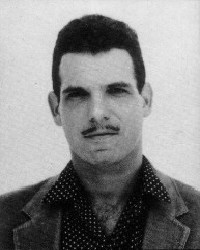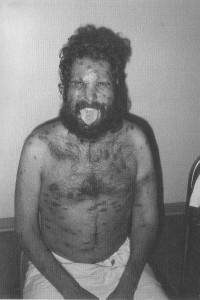Queers of the
Desert
Eric Michaels
 © Empress
Publishing.
© Empress
Publishing.
|
I
clearly remember the first time I met Eric. It was
the same day as I arrived to live in Alice Springs;
August 11, 1984. Not that we were strangers. We had
been corresponding in the months before I left
Sydney and established that not only would we both
be gay men living in Central Australia, but that we
would both be researchers working with Aboriginal
people. Quite a coincidence!
Eric was so keen to
meet me that he appeared at my hosts' house within
hours of my arrival and dragged me round to the
Gap Hotel for a drink. I can still vividly recall
watching the replay of the Los Angeles Olympics
closing ceremony while listening to his critique
of his own American culture.
|
Although we got along well and
maintained a long friendship and professional association, we
were never very close. He would drop into my office when in
town, or I would bump into him at a party or on a field trip
to Yuendumu. On a few occasions I was lucky enough to hear him
speak on Indigenous arts at conferences. Eric's perceptions
and analyses were quite brilliant.
In the foreword of Eric's diary,
Paul Foss summarised his career in these terms:
"After finishing his doctorate,
Eric accepted a fellowship from the Australian Institute of
Aboriginal Studies in Canberra to research the impact of
television on remote Aboriginal communities - eventually
published as The Aboriginal Invention of Television,
1982-86 (Canberra, AIAS, 1986). He remained in the
Central/ Western Desert region where he involved himself in
claims by Aboriginal media associations for increased local
autonomy in video production and circulation (cf. "Aboriginal
Content: Who's Got It - Who Needs It", Art & Text,
23-24, 1987; and For a Cultural Future: Francis
Jupurrurla Makes TV at Yuendumu, Melbourne, Art &
Criticism Monograph Series, Vol. 3, 1988). At the same time,
Eric became interested in the new acrylic 'dot paintings'
carried out at Yuendumu and Papunya, occasioning the essays
"Western Desert Sandpainting and Post-Modernism" (in
Warlukurlangu Artists, Kuruwarri: Yuendumu Doors,
Canberra, AIAS, 1987) and "Bad Aboriginal Art" (Art &
Text, 28, 1988). With these writings, exemplary in their
refusal to romanticise indigenous cultures, Eric gained a wide
following in Australia for his non-ethnographic approach to
Aboriginal video and art."
Michaels, E. (1990).Unbecoming:
an AIDS diary. Sydney: Empress Publishing. pp. 12-13.
But, what distinguished Eric's
life as much as his brilliant career was its end. Eric was one
of the first known residents of Central Australia to die with
AIDS. And, in typical style, he did that in a very public and
assertive fashion by documenting the last months of his life in
a diary that was to be published after he had gone. Unbecomingis
a remarkable volume. It is a confronting, 'warts and all'
account of what seems like everything he did and said and
thought as the virus took its final toll.
Eric left the region before his
death, presumably to seek treatment, and ended up in Brisbane.
From there he reflected on many things, including his life as an
isolated gay man in Central Australia:
"16 February 1988.
At Yuendumu, something else
happened, over time. In the beginning, I would arrange to get
down to Sydney every few months for a weekend, and then, look
out Daddies! I knew what cowboys felt like when they got into
Dodge after months on the range. I barely had time to talk.
Curiously, during three years of this, I barely met anybody
(except Martin), never was invited home, went to any parties,
etc. etc. The fault was mine; I didn't have time to date. When
back in the bush, I carefully nurtured a small gay video
collection (safer than magazines), and used to cherish the
rare occasions of privacy that provided an opportunity to jerk
off to them (privacy soon becomes the most cherished and rare
commodity for the modern Westerner living in most tribal
societies). I developed quite elaborate relationships with my
video images. But over time, even this novelty wore off.
Something curious happened also to my appearance; I stopped
posing in mirrors or considering my 'cosmetology'. I felt
quite liberated in some sense, acknowledged that what mirrors
were available was the community itself, and yet I was limited
in my ability to read those mirrors. By the end of the
fieldwork, my gay identity was problematised and backgrounded
in ways I never could have imagined, let alone tolerated, five
years before. It has made the transition to enforced celibacy
easier."
Michaels, E. (1990).Unbecoming:
an AIDS diary. Sydney: Empress Publishing. p. 100.
As the end drew close Eric
entertained the possibility of coming 'home' to die:
"10 August 1988.
Lots of good local and bushy
gossip. Jim B. was there just back from the Hobart AIDS
conference. He tells me about this Michael somebody from San
Francisco who has been at terminal stage for three years and,
with massive doses of bactrim, treats it merely as a chronic
illness, and keeps on keeping on. I told Jim I didn't know if
that seemed such an attractive prospect, staring yet again at
the blank walls of Wattlebrae as I spoke. Then, after the
phone call, I thought: Why not go to Alice Springs? Even if I
die getting there, the project still has more style than lying
here and being bored to death. There really are a full dozen
people there who would take on some responsibility for me, the
AIDS group is Jim and my friends, the aesthetics are appealing
- it would sure be cheaper than Sydney. So I indulged a
fantasy of Buckell driving me out, lying in the back of the
stationwagon, watching the desert go by again, getting to
Alice Springs and receiving in state for the few weeks left.
Even if by doing this I cut off a few possible days or weeks
extra, it seems worth it. I sure can't motivate any optimism
for continuing on like this here in Brisbane, but a few extra
weeks might seem worth it in Alice."
Michaels, E. (1990).Unbecoming:
an AIDS diary. Sydney: Empress Publishing. Pp. 184-185.
| I doubt Eric realised it at
the time, but his announcement sent those of us
involved in the then Central Australian AIDS Action
Group into a major spin.
As far as we knew Jim
would soon be driving to Brisbane to collect Eric
and bring him back to see out his remaining days.
Various strategies were discussed and a quick
succession of phone calls and meetings ensued.
We canvassed a range of
options for his accommodation, settling on the offer
of a caravan in someone's back yard as the best
option available. And then we waited for the call to
tell us that the arrangements had been made at the
other end and he was ready to be collected.
|

© Empress
Publishing.
|
But, the call that finally came was
simply to tell us that it was all over. The wild idea to
return to the desert was actually the final entry Eric made in
his diary. He died two weeks later on 24 August, 1988.
The last image of Eric shows the
ravages of Kaposi's Sarcoma; a rare form of skin cancer
prevalent in the early years of the epidemic. It is almost
unheard of these days thanks to advances in treatments. It is
definitely a shocking image, but one that Eric chose to be
published as his final one. As well as a clinical photo to
evidence his ultimate reality, it was also clearly one last
opportunity for him to poke his tongue out at the world.
After his death a group of Eric's
friends and colleagues from Yuendumu and Alice Springs
produced an AIDS quilt in his
memory.
Eric's significant contribution to
Aboriginal and media studies are also remembered through some
online publications including the Web
Archive
in Visual Anthropology which has published his doctoral
thesis;Tribal TV, and a complete issue of Continuum:
The
Australian Journal of Media and Culture published
in 1990.
John Hobson

